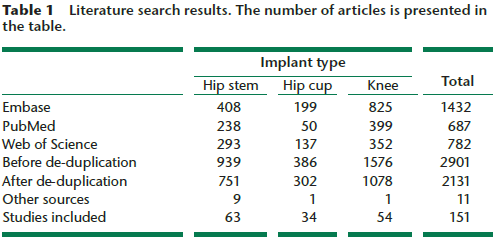
The objective of this systematic review was to give an overview of clinical investigations regarding hip and knee arthroplasty implants published in peer-reviewed scientific medical journals before entry into force in May 2021 of the EU Medical Device Regulation.
Authors: Anne Lübbeke, Christophe Combescure, Christophe Barea, Amanda Inez Gonzalez, Keith Tucker, Per Kjærsgaard-Andersen, Tom Melvin, Alan G Fraser, Rob Nelissen and James A Smith
Little is known about the clinical evidence used to establish the safety and performance of medical devices before and after market access in Europe. Unlike medicines in Europe and in the USA, and medical devices that are subject to pre-market authorization in the USA, there has been no requirement for summaries of clinical evidence to be made publicly available. Under the Medical Device Directive 93/42/EEC (MDD) system, which is still the legal basis for the marketing of the vast majority of medical devices today, it is not possible to identify the clinical evidence supporting device CE-marking (Conformité Européene) as this is considered to be commercially confidential (Article 20 of the MDD). This might be the reason for the very few detailed analyses on evidence for medical devices being published.
Methods: The medical literature was systematically reviewed for a random selection of hip and knee implants to identify all peer-reviewed clinical investigations published within 10 years before and up to 20 years after regulatory approval. Study characteristics, methodologies, outcomes, measures to prevent bias, and timing of clinical investigations of 30 current implants were reported. The review process was conducted according to the Preferred Reporting Items for Systematic Reviews and Meta-Analyses (PRISMA) guidelines.

Results: 2912 publications were identified and finally included 151 papers published between 1995 and 2021 (63 on hip stems, 34 on hip cups, and 54 on knee systems). No clinical studies published before Conformité Européene (CE)-marking for any selected device were identified, and no studies even up to 20 years after CE-marking in one-quarter of devices. There were very few randomized controlled trials, and registry-based studies generally had larger sample sizes and better methodology.
Conclusion: The peer-reviewed literature alone is insufficient as a source of clinical investigations of these high-risk devices intended for life-long use. A more systematic, efficient, and faster way to evaluate safety and performance is necessary. Using a phased introduction approach, nesting comparative studies of observational and experimental design in existing registries, increasing the use of benefit measures, and accelerating surrogate outcomes research will help to minimize risks and maximize benefits.
To read and download the full systematic review, click here.


